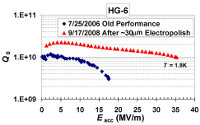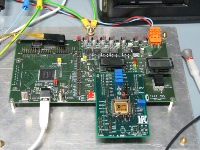From Jefferson Lab News: ILC treatment of JLab cavity garners exciting result

Before the ILC-style electropolish, the accelerating gradient of this Jefferson Lab accelerator cavity topped out near 17 megavolts per meter (MV/m), a measure of the cavity's ability to impart energy to electrons. After processing, the cavity's accelerating gradient jumped to 35 MV/m. |
For the last few years, Jefferson Lab staff members have used the lab's unique facilities to test various accelerator components for a proposed next-generation collider, the International Linear Collider. Reminiscent of a stack of doughnuts, accelerator components called cavities energize particles for use in experiments that explore the smallest bits of matter.
Read more...
|
|
 |
ECal: a piece of the jigsaw reaches a milestone

The generic motherboard designed at LPC, testing the analogue-to-digital converter prototype. |
Hundreds of millions of channels of electronics: this is about what the electromagnetic calorimeter (ECal) of the CALICE collaboration will have to design, process and analyse. The very high granularity of ILC detectorís future calorimeter will also be reflected in the ambitious first-stage electronics Ė or very-front-end electronics, which still needs to be designed. One part of the electronic jigsaw is the analogue-to-digital converter (ADC). At LPC, a CNRS/IN2P3 lab in Clermont-Ferrand, France, the latest ADC prototype fulfills the ILC requirements in terms of resolution, compactness, time of conversion and power consumption.
Read more...
-- Perrine Royole-Degieux |
 |
|
|
 |
From JLab: Second chance

This accelerator cavity was worn out. It had been washed, baked and tested so much that its performance suffered, eventually declining below minimum specs. Researchers undertook a last-ditch effort to breathe new life into the beleaguered cavity and were rewarded with an astounding result.
Read more in today's Around the World story (Photo: JLab)
|
 |
|
|
 |
From The Guardian
2 February 2009
Five mysteries of the universe
Everything in the universe is either mass or energy, but there's not enough of either. Scientists think 96% of the cosmos is missing.
Read more... |
|
From Chard & Ilminster News
2 February 2009
Einstein's physics on violin
EINSTEINíS theoretical physics will be accompanied by his favourite instrument in a lecture with a difference at Dillington this weekend.
Read more... |
|
From Houston Chronicle
31 January 2009
SUNDAY CONVERSATION: Physicist warns of science gap
... Had that not happened, scientists from all over the world would have been working here, along with the small companies that grow up around these large experiments. If we donít provide these experimental facilities, eventually people just arenít going to come here, and weíll be left in the dust.
Read more... |
|
From Scientific American
30 January 2009
Quantum Divorce: When Entanglement Doesn't Work Out
A phenomenon called entanglement sudden death can break critical quantum links
Read more... |
|
From The Chronicle of Higher Education
30 January 2009
Physicists Set Plan in Motion to Change Publishing System
In what some are calling a peaceful revolution, researchers have mounted a takeover of high-energy-physics publishing.
Read more... |
|
|
 |
 |
|
|
 |
FALC meets in Madrid

Walter Davidson, new secretary of FALC, and Pierre Coulombe, new chair of FALC |
The Funding Agencies for Large Colliders (FALC) held its semi-annual meeting in Madrid, Spain on 19 January. FALC is an informal group of agency and government representatives that provides oversight for the Global Design Effort on resource and project planning matters. More broadly, FALC is a forum for information exchange for agency and government representatives from the different countries, especially regarding major international initiatives in particle physics. The Madrid meeting marked the transition of the chairmanship of FALC from Roberto Petronzio (the National Institute of Nuclear Physics INFN, Italy) to Pierre Coulombe (National Research Council, Canada). The meeting had two components: presentations of science in Spain and discussions of the worldwide particle physics programme, including planning for the International Linear Collider, by FALC.
Read more...
-- Barry Barish
Director's Corner Archive |
 |
|
|
 |
New deadline for TILC09
The Local Organising Committee for the upcoming joint ACFA physics and detector workshop and the GDE meeting
on the International Linear Collider (TILC09 for short) would like to inform you that they are extending the deadline for
early registration to 28 February. TILC09 will take place at EPOCHAL Tsukuba in Tsukuba City, Japan, from Friday 17 April to Tuesday 21 April.
Check the website for more information.
Registration and reservation for hotels should be done here.
Those of you who need visas to enter Japan should contact the conference secretariat at
tilc09office@ lcdev.kek.jp no later than
20 February, 2009 to obtain necessary paperwork. Registration fees are 40,000 Japanese yen for early registration and 45,000
Japanese yen for late registration.
arXiv preprints
0901.4873
Simulation study of ZHAH mode in Littlest Higgs Model with T-Parity
0901.4869
ILC Main Linac Alignment Simulations using Conventional Techniques and the Rapid Tunnel Reference Survey Model (RTRSM)
0901.4863
Measurements of the model parameter in the littlest Higgs model with T-parity
0901.4838
Neutralino Relic Density in the CPVMSSM at the ILC
0901.4822
TPC Readout Electronics with Time-to-Digital Converters
0901.4815
Silicon Detectors for the Large Prototype TPC test setup at DESY
0901.4741
Development of Vertically Integrated Circuits for ILC Vertex Detectors
0901.4700
Pinning Down the Invisible Sneutrino at the ILC
0901.4670
PFA Performance for SiD
0901.4656
Kinematic Fitting in the Presence of ISR at the ILC
0901.4639
The ILC DEPFET Prototype: Report of the Test Beam at CERN 2008
0901.4532
Implementation of Particle Flow Algorithm and Muon Identification
0901.4457
A digital ECAL based on MAPS
0901.4455
Reduction Method for One-loop Tensor 5- and 6-point Integrals Revisited
0901.4446
Beam Size Measurement with Pair Monitor and BeamCal
|
|

